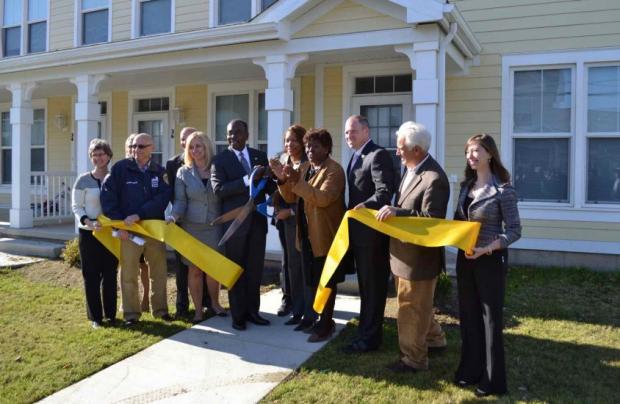BMHA Opens New Housing While Older Units Stagnate
Standing in front of a two-story suburban-style home with yellow siding and white trim representatives from the Buffalo Municipal Housing Authority, the city, the state, developers and the U.S. Department of Housing and Urban Renewal posed for pictures while bisecting a long yellow ribbon with a set of massive scissors. The dignitaries were celebrating the completion of third and final phase of an affordable housing project—almost ten years in the making—at the A.D. Price housing development. In total 50 units, already completely occupied, have been added to the housing authority’s portfolio.
Dawn Sanders-Garrett, the housing authority’s executive director, beamed from behind a podium in the nearby community center before the ribbon cutting, speaking in an exuberant tone and noting the warm, bright sunshine outside, an uncommon occurrence for November in Buffalo. While the optimistic demeanor persisted throughout her comments, Sanders-Garrett spent significant time detailing the many challenges that remain for her organization, and called on the elected officials in the room to push for more funding.
“When you have housing that is over 80-years-old of course there’s going to need to be some money allocated to address the capital needs of this organization,” she said.
Outside at the ribbon cutting, a monument to one of the largest hurdles for the authority, more than 400 hundred units of unlivable, derelict units, lingered in the background.
Surrounding the new units are the two-story long, brick buildings with broken windows and tattered sheets still hanging as shades, that are the original A.D. Price Courts development. The relics sit empty, with 170 units deteriorating and no active plan for demolition or renovation. The authority is seeking to tear them down and build more units like those on surrounding plots, but as of now no funding is in line for those plans.
Those units are among the 342 BMHA is seeking to replace as part of a larger turnaround plan, submitted to HUD this spring after the federal agency required them to turn in a comprehensive scheme to address its occupancy rate, which has hovered at around 84 percent, earning a designation of “substandard.”
The federal housing authority, which is the main funder of BMHA activities, went so far as to threaten receivership if a plan was not submitted and implemented, a rare move.
Sanders-Garrett, with Buffalo Mayor Byron Brown, Assemblywoman Crystal Peoples-Stokes and state Sen. Tim Kennedy all sitting directly in front of her, called on the elected officials to work to deal with cuts to federal funding and bureaucratic hurdles in order to help the agency execute its plan.
“I want to take the time to thank everyone who has come out and joined us today, but I hope it’s not the last time,” Sanders-Garrett said. “The residents of public housing need you.”
Peoples-Stokes, after a brief conversation with Sanders-Garrett during a tour of one of the homes, said she plans to take that message back to Albany.
“We’re going to start working on that right away and make sure during the budget process that we get our fair share,” Peoples-Stokes said.
She added that running the message up the chain to legislative leadership now is necessary to highlight that it is an important issue for the Buffalo delegation.
“The governor is going to present his budget in January,” Peoples-Stokes said. “Hopefully he will have heard our opinion before then.”
While $12 million project – funded by the housing authority, New York State Office of Homes and Community Renewal and HUD — will provide new homes for many families it does little to address the housing authority’s occupancy rate issues. The additional 50 units is a small percentage of the more than 4,300 total units on the authority’s books and estimates suggest it would cost $300 million to address all its capital needs.
Joan Spilman, HUD’s director for its Buffalo office, was also on hand for the ceremony. She praised the many parties involved in the housing development, noting that a number of factors, including funding cuts at the federal level, have made it necessary to bring many groups together to accomplish what used to be handled by a few agencies.
“Days are gone when one source of funding can provide this kind of development,” Spilman said. “It requires all of us working together and it’s a difficult process.”
After the press event Spilman told City & State that her office’s work with BMHA on improving occupancy rates is a “challenge,” but that the housing authority has continued to work with HUD on its submitted plan.
“Some of their occupancy rate is because there are units that can’t be inhabited because they kept them out of occupancy and they don’t have funding to upgrade,” Spilman said.
Her agency will continue to meet with BMHA officials and work with them to improve, Spilman said.
“We expect things to work out. We expect them to get better.”
The article appears courtesy of a content sharing agreement between The Public and City & State-

